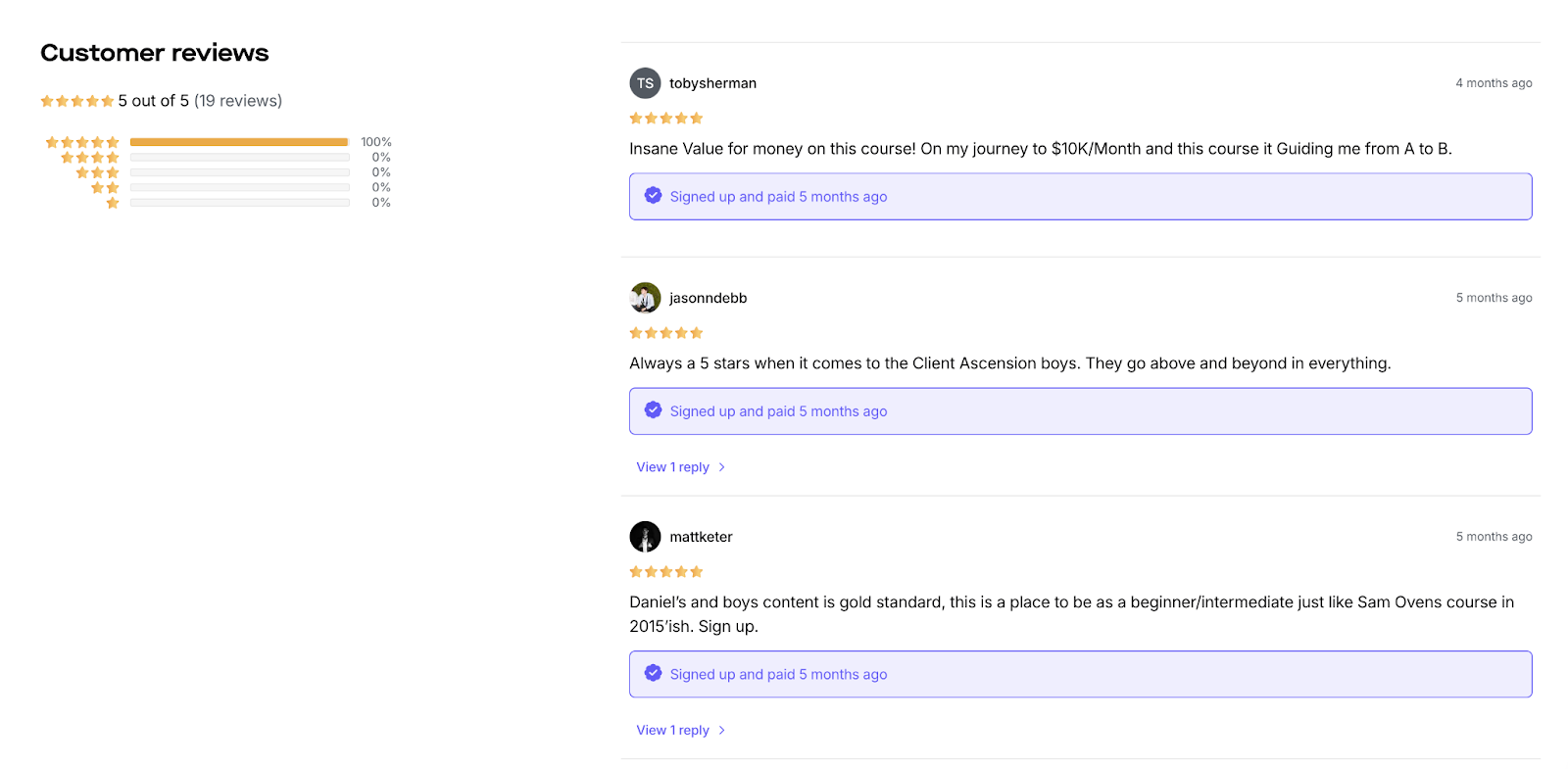Marketing is key to the success of your digital products. Discover 16 ways that you can market your digital products in this guide.
Key takeaways
- Digital products offer low production costs, easy global distribution, and passive income potential once created.
- Build pre-launch excitement through teasers, early-bird pricing, and beta access to avoid launching to silence.
- Combine content marketing, email campaigns, and social media while tracking traffic sources to maximize reach and conversions.
Selling digital products is one of the easiest ways to start an online business.
Costs are low, you don’t need storage or shipping, and the logistics are pretty simple.
There is one catch, though: the market is crowded. How crowded?
Well, digital products generate over $2.5 trillion every year. The earning potential is obviously there, but so is the competition.
Selling is one thing, but a good digital product on its own isn’t enough.
If you really want to maximize sales, stand out, and grow? You need to know how to actually market your digital products to the right people, in the right way.
Keep reading to find out how.
What are digital products?
Digital products include any offer, goods or services delivered electronically.
Because they don’t require manufacturing, storage, or shipping, they’re low-cost to create, easy to distribute, and a great option for beginner entrepreneurs.
Here are some of the most common types of digital products in 2025:
- Software: Apps, programs, and tools built for specific tasks—like productivity suites (e.g., Microsoft Office) or design tools (e.g., Adobe Photoshop). Software can be sold as a one-time purchase, a subscription, or through licensing.
- Digital art and design: This includes illustrations, graphics, 3D models, and photography. Businesses, marketers, and consumers use these assets for everything from branding to ad campaigns.
The NFT market surge dipped a little from its peak of 1.6 billion in 2023, but it’s stabilizing between $600-700 million this year – so there’s still opportunity there too.
- eBooks: Digital books in formats like PDF, EPUB, or Kindle. They can cover fiction, non-fiction, how-to guides, or niche expertise.
- Online courses: Educational content delivered through platforms like Whop, featuring video lessons, written resources, quizzes, and assignments.
The e-learning industry is expected to reach $842 billion by 2030, making this one of the fastest-growing digital product categories.
- Printables: Downloadable files such as planners, calendars, art prints, and worksheets. Sites like Etsy remain popular marketplaces for these products.
- Audio and visual content: Includes music, podcasts, audiobooks, movies, animations, and tutorials. These are consumed globally for both entertainment and learning.
- Mobile and web apps: Apps for smartphones and tablets, spanning games, utilities, productivity, and social media.
- Subscriptions & memberships: Access to exclusive content, tools, or services on a recurring basis. Examples include premium newsletters, community memberships, software subscriptions, or ongoing course access. Great for building predictable, recurring revenue.
- AI digital products: Tools or content enhanced by artificial intelligence, such as personalized learning apps, AI-generated art packs, chatbots, writing assistants, or productivity tools.
The pros and cons of selling digital products
Obviously, selling digital products is one of the most popular ways to make money online.
I mean, once you make a product, it can keep earning money without much extra work, making it possible to build passive income over time.
But like any business, selling digital products isn’t without its hurdles. There are some basic challenges you need to be aware of, from piracy to refunds.
The pros outweigh the drawbacks in most cases, but understanding what they are can help you decide whether digital products are the right hustle for you.
Pros of selling digital products
- Low production costs: Once made, digital products cost almost nothing to sell. No manufacturing, inventory, or shipping needed.
- Growth is easy: You can sell to one customer or a million without much extra cost.
- Passive income potential: After creation, digital products can keep earning money with minimal effort.
- Easy distribution: Products can be delivered instantly online, anywhere in the world.
Cons of selling digital products
- Intellectual property theft: Digital products can be pirated or shared without permission, which can hurt profits.
- Refunds and chargebacks: Customers may request refunds if they’re unhappy. Mistakes in a product can’t be “restocked,” only fixed.
Whop helps you to fight disputes and chargebacks with ease.
- High competition: Because digital products are easy to create and sell, the market is crowded. Standing out among thousands of similar products can be tough, and you’ll need strong marketing to attract buyers.
Marketing your digital products
You know what digital products are, and you’ve learned the pros and cons of selling them. So, let’s talk about how to get them in front of the right people.
Marketing digital products takes a pretty strategic approach that focuses on your unique value, your audience, and the right platforms.
Let's walk through 16 steps to marketing successfully and banking more sales.
1. Decide on your digital product
Gotta figure out what you’re selling first.
Define exactly what you’re creating: online courses, digital art, eBooks, AI tools, or subscriptions.
The type of product affects your marketing strategy and which platforms are best.
For example, online courses often perform well on platforms like Whop, Udemy, or Teachable, while digital art or printables might sell better on Etsy.
Unlike other marketplaces, Whop caters to every niche. You can sell anything from printables to SaaS, merch to courses, all under one roof.
Read: The best online course platforms to sell your course
2. Identify your ideal buyer

Next: Who are you marketing to?
Know your target persona’s age, interests, profession, and online behavior.
Trust me, understanding who your buyers are guides your messaging, ad targeting, and content creation. Otherwise? You’re screaming into the void and wasting time and money.
Identify the main problem your product solves, who it solves it for, and how fast it can help – and highlight that in all marketing materials.
3. Create some hype
Nothing is worse than launching to crickets.
To avoid sloping, build excitement with pre-launch campaigns:
- Sneak peeks or previews: Share behind-the-scenes content, teaser videos, or product mockups on social media.
- Countdown timers: Use website or email countdowns to build urgency and signal a big launch.
- Special pre-order deals: Offer early-bird pricing, limited editions, or bonus content for those who purchase before launch.
- Beta access groups: Invite a small group of loyal fans or subscribers to try the product first and provide feedback.
- Gamified challenges: Run contests or challenges leading up to launch to boost engagement and user-generated content.
- Exclusive previews in communities: Share sneak peeks in niche forums, Discord servers, or Whop communities.
4. Use content marketing
Use your organic content to get your audience excited and prepped to buy. Provide valuable content through blogs, tutorials, videos, podcasts, or even mini-courses to attract and educate your audience.
Make sure you include calls-to-action (CTAs) in content that lead directly to your product, free trials, or lead magnets.
Also, you can repurpose content across multiple channels (social media, email newsletters, forums, and marketplaces) to maximize reach and save time on content creation.
Speaking of repurposing? Use Whop's Content Rewards and have clippers spread your content for a fraction of the cost of paid social ads.
Track engagement metrics like time on page, shares, and comments to refine content strategy and identify what resonates most with your audience.
5. Use email campaigns
Share product launches, updates, or promotions with subscribers.
Tip: Segment your list by behavior or interest to send more personalized messages, and test subject lines and copy for higher open and conversion rates.
Use Whop's MailModo integration to effortlessly send EDMs from the same place you sell, manage payments, and profit.
Read: Best email newsletter software for entrepreneurs
6. Use social media marketing
You can reach both organic and paid audiences on platforms like TikTok, Instagram, LinkedIn, and YouTube.
Experiment with short-form videos, carousel posts, or live sessions to showcase product features and answer questions in real time.
Some platforms have limitations for digital products: for example, TikTok Shop doesn’t support direct digital product sales, so focus on driving traffic to your own store or marketplace listing with a link in your bio.
You can also use AI tools to speed up content creation: think generating captions, subtitles, or quick video snippets.
To drive engagement, use interactive features such as polls or Q&A sessions to engage your audience and understand their interests.
Read more about selling digital products with social media:
7. Offer free trials, promos, or demos
Giving potential customers a chance to experience your product before committing can hugely increase confidence and reduce hesitation.
Free trials, limited-time demos, or special promotional offers allow users to explore features, understand the value, and see how it fits their needs.
This approach not only boosts conversions but can also generate early feedback to improve your product, giving you social proof to use early on.
Read: Optimal free trial length for digital products
8. Collect testimonials and reviews

Speaking of social proof: reviews and testimonials are powerful motivators in the decision-making process.
Encouraging satisfied customers to leave reviews and testimonials about your product and showcasing them on your website, social media, and other marketing materials can build trust and credibility for your digital product and brand.
Read more about social proof:
9. List on popular online marketplaces
Selling on large, well-known marketplaces such as Whop, Etsy, and Amazon exposes your product to active audiences who may not be familiar with your brand.
Read: How to write an offer headline that stops the scroll every time
Optimizing titles, descriptions, and visuals for each platform is key to helping your listings stand out.
Make sure you monitor competitor offerings so that you can discover trends and gaps in the market.
Whop's marketplace has millions of customers each month. It’s super easy to get started and the transaction fees are some of the lowest in the industry, with no platform subscription fees.
10. Think about traffic
Understanding where your visitors are coming from (organic search, social media, paid ads, or referral links) is essential for figuring out which marketing strategies are worth the time and effort.
Use tools like UTM parameters, analytics dashboards, and heatmaps to track user behavior, engagement, and conversion paths.
By identifying which channels deliver the most valuable traffic, you can optimize campaigns and repeat what worked before across platforms.
11. Optimize for SEO

Search engine optimization (SEO) helps your digital products appear in search results and attract organic traffic.
Use keyword-rich titles, descriptions, and content, and regularly update your pages to reflect trends or customer needs. Incorporate internal linking, answer common questions, and create high-value content to improve visibility and click-through rates.
SEO is a long-term strategy that builds credibility, drives free traffic, and complements other marketing efforts like social media and email campaigns.
12. Use affiliate marketing
Affiliate marketing lets others promote your products in exchange for a commission, helping you expand reach without spending upfront on ads.
Every whop comes with its own affiliate program, making it easy for people to share your product and earn money. Affiliates get 30% of what Whop makes from each new buyer, so you don’t lose any profit while encouraging others to promote your product.
Provide affiliates with ready-made creatives, messaging, and tutorials so they can market your product consistently and effectively.
13. Seasonal promotions and campaigns
Tying product offers to holidays, seasonal events, or trending topics can generate higher engagement and sales.
Limited-time bundles, exclusive content, or special editions create urgency and encourage customers to act quickly.
Testing different seasonal angles can also reveal what resonates most with your audience, allowing you to refine future campaigns and capitalize on recurring opportunities throughout the year.
14. Retargeting paid ads

No matter how dope your product is, not every visitor will buy on their first visit.
That’s why retargeting your ads is crucial for converting interested users. Display ads to those who have engaged with your site or products, such as cart abandoners or page viewers.
Segment audiences based on activity level and personalize ad creatives with specific product highlights, promotions, or reminders to increase the likelihood of conversion.
Retargeting ensures your product stays top-of-mind and maximizes the ROI of your paid marketing.
15. Host webinars or live events
Live demonstrations or webinars give potential customers a chance to see your product in action and ask questions in real time.
Hosting interactive sessions builds trust, showcases value, and allows you to address objections before they arise.
Including live Q&A, limited-time offers, or exclusive bonuses encourages immediate purchases while also creating content that can be repurposed for future marketing efforts.
You can host free and paid livestreams on Whop, giving you an easy way to connect with buyers and members and generate a funnel from interest to purchase.
16. Collaborate with other creators
Teaming up with other creators or brands is a smart way to reach new audiences and level up your product.
Co-create content, bundle stuff together, or do cross-promos to get more eyes on your work while sharing some credibility.
Keep an eye on clicks, sales, and conversions from each collab, and switch up partners regularly so things don’t feel stale.
Partnerships are a fun way to network with other creators, tap into new communities, and grow your own following at the same time.
Market your digital products effortlessly with Whop
Whop makes it easy to sell and manage all kinds of digital products – eBooks, courses, apps, videos, and more – from a single hub.
Build interactive courses, host webinars, run chats and forums, and even do giveaways to engage your community, all without coding.
Social proof is built in: Showcase reviews, comments, and active members to boost trust and credibility.
With no upfront costs and just fees as low as 2.7%, Whop is the obvious place to launch, sell, and market digital products.
Start selling and building a community around your offers on Whop today: one platform, unlimited ways to earn.
How to Market Digital Products FAQs
The frequently asked questions about how to market digital products
What Platforms Are Best for Selling Digital Products?
Platforms like Whop, Amazon, and Etsy are great for selling digital products. Optimize your listings with compelling details and utilize the platform’s marketing tools to maximize visibility and sales.
How Do I Drive Traffic to My Digital Products?
To drive organic traffic, leverage social media platforms by sharing engaging content and using relevant hashtags. Focus on content marketing by creating blog posts, videos, or tutorials related to your product. For paid traffic, use tools like Google Ads, LinkedIn Ads, and Meta Ads to give a boost to your ads reach.
- What is Digital Dropshipping and How to Get Started?
- How to Create Digital Products With No Experience
- Digital Product Strategy: Building a Roadmap to Create, Market, and Grow Your Digital Product Business
Why You Should Trust Us
Joe Niehaus is a seasoned content writer and ecommerce expert at Whop. He brings extensive experience in managing affiliate programs for a variety of ecommerce brands. His expertise has also been featured on leading platforms like Travel + Leisure and Business Insider.



